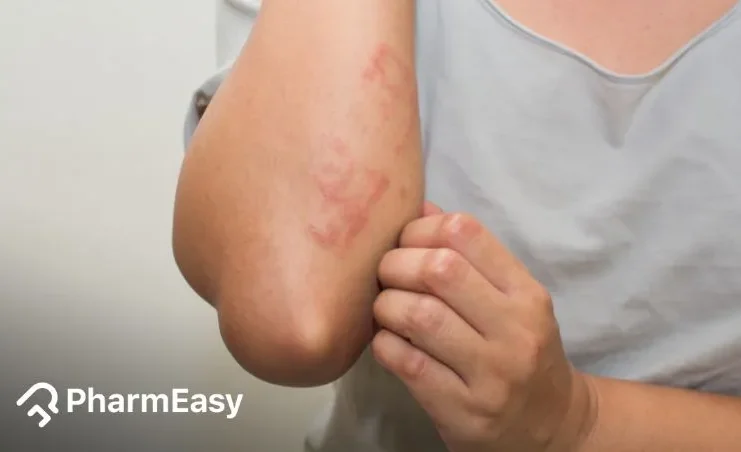Red Spots on Skin: Causes, Symptoms, Treatment and More!
By Dr. Raina N. Nahar +2 more

Get,

to manage your symptom
Get your,


4 Cr+ families
benefitted

OTP sent to 9988776655



You’ve successfully subscribed to receive
doctor-approved tips on
Whatsapp

Get ready to feel your best.

Hi There,
Download the PharmEasy App now!!


Register to Avail the Offer
Send OTPBy continuing, you agree with our Privacy Policy and Terms and Conditions

Hi There,
Sign up on PharmEasy now!!
Trusted by 4 crore+ families

OTP sent to 9988776655



You have unlocked 25% off on medicines




Code: NU25
By Dr. Raina N. Nahar +2 more
Table of Contents
Skin conditions can have a significant impact on our everyday lives, causing discomfort or pain, and even affecting aesthetics. Red spots are a common complaint, affecting people of all ages and backgrounds. In this blog post, we will explore the different causes of red spots on the skin, their associated symptoms, and various research-based treatment strategies. We will also highlight when seeking medical advice is crucial and support you in understanding when home treatments may suffice. By understanding these, you can make informed decisions about managing your skin health and possibly avoiding further issues.

There are several causes of red spots on skin. These can be due to infections or allergies or may be a symptom of some medical problems like immune-medicated conditions or bleeding disorders. It’s important to understand the underlying cause for appropriate management.
Some common causes include:
Heat rash, also known as miliaria, comes up when sweat glands get blocked. This traps sweat within the skin, causing red, itchy, and at times painful bumps1.
Symptoms and appearance
Triggers
Chickenpox and shingles are both due to the varicella-zoster virus2. They can result in an itchy, red, blistering rash.
Symptoms and appearance
Triggers
Rubella, also known as German measles, is a viral infection3. It causes a red, blotchy rash that spreads across the body.
Symptoms and appearance
Triggers
Impetigo is a bacterial infection of superficial layers of skin4. It is common in hot humid climates and is highly contagious..
Symptoms and appearance
Triggers
Scarlet fever is a bacterial infection caused by group A streptococci. It results in a red, sandpaper-like rash5.
Symptoms and appearance
Triggers
MRSA (methicillin-resistant Staphylococcus aureus) is a type of bacterial infection. It is resistant to many antibiotics, causing red, swollen skin.
Symptoms and appearance
Triggers
Insect bites can cause red spots on the skin, along with itching or pain. Fleabites often occur on the lower legs and feet. They cause small, itchy, red bumps.
Symptoms and appearance
Triggers
Tick bites can result in red, inflamed spots on the skin that may grow larger over time.
Symptoms and appearance
Triggers
Swimmer’s itch, or cercarial dermatitis, is a rash caused by skin contact with tiny parasites found in freshwater or seawater.
Symptoms and appearance
Triggers
Keratosis Pillaris is usually a hereditary condition caused by excessive keratin production on skin which blocks the hair follicles and causes tiny red bumps on skin6.
Symptoms and appearance
Triggers
SLE is an autoimmune disease. It can cause a distinct “butterfly” rash across the cheeks and nose7.
Symptoms and appearance
Triggers
Psoriasis is an autoimmune skin condition. It causes red, scaly patches on the skin, usually on the elbows, knees, and scalp7.
Symptoms and appearance
Triggers
Lichen planus is an autoimmune skin condition. It causes purplish-red, itchy bumps or lesions on the skin.
Symptoms and appearance
Triggers
Petechiae are tiny, pinpoint, red, or purple spots on the skin. They happen due to microvascular bleeding8.
Symptoms and appearance
Triggers
Purpura refers to larger patches of blood spots than petechiae. They can come from a variety of causes like infections, blood clotting disorders, or trauma.
Symptoms and appearance
Triggers
Cherry angiomas are tiny, harmless growths of blood vessels. They show up as red or purple spots on the skin.
Symptoms and appearance
Triggers
Contact dermatitis comes up when the skin touches an allergen or irritant9. This could be poison ivy, nickel, or chemicals in hygiene products or cosmetic items.
Symptoms and appearance
Triggers
A drug allergy is when the immune system overreacts to a drug. It can result in a red, itchy rash.
Symptoms and appearance
Triggers
Atopic dermatitis, or eczema, is a long-term, inflammatory skin condition. It causes red, itchy, and scaly rashes10.
Symptoms and appearance
Triggers
Seborrheic eczema is a type of eczema or skin inflammation due to excessive oil production. It affects the scalp and other oily parts of the skin. This causes red, itchy, and flaky patches.
Symptoms and appearance
Triggers
Acne vulgaris, a common skin condition often called as pimples. It causes red spots, bumps, and inflammation on the skin.
Symptoms and appearance
Triggers
Rosacea is a chronic skin condition. It causes redness on the face, visible blood vessels, and red, pimple-like bumps11.
Symptoms and appearance
Triggers
Some red spots on the skin, commonly referred to as a petechial rash, are actually tiny bleeding spots beneath the skin13.
Dr. Siddharth Gupta, B.A.M.S, M.D (Ayu)
Red spots on the skin show various symptoms. These may include:
Itching is a common symptom linked to many types of red spot. It can range from mild to severe and might be associated with a scaly, flaky texture or swelling.
Some red spots can cause pain, notably if they result from an infection, inflammation, or trauma. It’s crucial to check the level of pain experienced and get medical help if it gets worse or doesn’t get better with time.
Swelling may happen around red spots, particularly if they’re caused by an infection or an insect bite. This can end up in a raised, tender spot on the skin.
In some cases, red spots can get crusted or bleed fluid. This is often seen in conditions like impetigo, MRSA infection, or shingles. If you notice crusting or oozing, consult a healthcare professional for the right diagnosis and treatment.
Red spots on the skin may change colour over time, based on how the underlying cause progresses and the person’s skin tone. As the red spots heal or go away, they may darken, fade, or turn purple, grey, or brown.
However, self-diagnosis and treatment should be avoided, and a dermatologist should always be consulted for the proper diagnosis and management of your condition.
In some cases, red spots may be associated with symptoms like fever, chills or difficulty in breathing. These are usually due to infections or a major allergic reaction and require prompt medical attention12.
Research13 has shown that the presence of red spots on the skin can indicate underlying blood disorders including conditions like immune thrombocytopenic purpura.
Dr. Rajeev Singh, BAMS
Also Read: 7 Reasons Why Vitamin C Is Good For Your Skin
There are many evidence-backed ways to treat red spots on the skin. Which one you go for depends on the root cause and the severity of symptoms. Remember to always take these treatments under the guidance of your health care professional.
Some commonly available medications may help to relieve red spot symptoms. These may include:
Topical creams
Remember even though these drugs are available without a prescription, it is advisable to keep your health care professional in the loop.
If these don’t help, your healthcare provider may prescribe medications to specifically treat the underlying cause of red spots on the skin. These may include:
Antihistamines
Oral antihistamines such as Cetirizine or Fexofenadine can help treat allergies and relieve itching and discomfort in some cases.
Systemic steroids and Immunosuppressants
For some autoimmune disorders like psoriasis or lupus, your healthcare provider may prescribe drugs that suppress the immune system such as prednisolone, cyclophosphamide etc. They help calm down the immune system and stop it from attacking the skin.
Antimicrobials
If your skin’s red spots are due to a bacterial infection, viral infection, or fungal infection your healthcare provider may prescribe antimicrobials to eliminate the infection. These include antibiotics such as cephalexin, clindamycin or ciprofloxacin, antivirals such as acyclovir or valacyclovir, or antifungals like clotrimazole and ketoconazole respectively.
Although further research is needed to corroborate their role in management of red spots on skin, some home fixes may help in providing relief from the disturbing symptoms associated with red spots. These can include:
Taking steps to avoid and manage red spots on the skin can also be useful. Below are some actions that may help lower the risk of the occurrence of red spots on the skin:
Also Read: Amazing Benefits of Moringa for Your Skin!
It’s important to seek medical advice if your red spots don’t get better with at-home treatments or if they get worse. In some cases, the red spots may show a more severe condition that needs medical intervention. Signs and symptoms that call for medical attention include7:
Possible complications of untreated or poorly treated red spots on the skin can comprise:
Getting the right diagnosis and treatment from a healthcare professional can help manage red spots efficiently. This can help improve overall skin health and quality of life.
Also Read: What Causes Low Creatinine
Taking care of red spots on the skin is crucial for maintaining your skin and overall health. Understanding the various causes and evidence-backed treatments may help you make informed decisions on how best to deal with these concerns. Make sure to identify possible triggers and to care for your skin regularly. Seek medical advice when needed for the right diagnosis and treatment options. By taking control of your skin health, you may lessen the impact of red spots on your daily life.
Leukaemia, a type of blood cancer can cause red spots, known as petechiae, due to small blood vessels bursting under the skin, although it not a very common cause. Red spots due to bleeding under skin, called as petechiae can also be caused by other reasons. A healthcare professional should look into it.
The seriousness of petechiae depends on its root cause. In some cases, they may be harmless and go away on their own. But in others, they may indicate a deeper medical issue that needs medical attention. It’s important to talk to a healthcare professional if you develop petechiae.
Heat rash (miliaria) is caused by blocked sweat glands and trapped sweat. This leads to small, itchy bumps on the skin. Sun rash results from exposure to the sun. It leads to red, itchy, and irritated skin. While both conditions may cause red spots and itching, they can be distinguished by when they come up and their specific symptoms.
Erythema multiforme is not contagious. It’s an allergic reaction, normally triggered by an infection or a drug. However, the infection that led to erythema multiforme may be contagious. However, not all individuals who get the infection will develop the rash.
Red spots on the skin can be caused by various conditions, ranging from benign issues like allergic reactions or infections to more serious concerns like skin cancer. While not all red spots are cancerous, it’s important to consult a healthcare professional for an accurate diagnosis and appropriate treatment.
Yes, diabetes can cause red spots on the skin. These can result from conditions such as diabetic dermopathy, which manifests as light brown, scaly patches, or from poor circulation and infections that are more common in individuals with diabetes. It’s important for people with diabetes to monitor their skin and seek medical advice for any unusual changes.
Yes, stress can cause red spots on the skin. It can trigger or worsen conditions like eczema, psoriasis, and hives, leading to the appearance of red, itchy patches. Managing stress is important to maintain overall skin health.
Yes, alcohol can cause red spots on the skin. It can lead to conditions like rosacea, which causes facial redness and visible blood vessels, and can also cause flushing or exacerbate allergic reactions, resulting in red patches.
Yes, red spots on the skin can be harmless. They often result from minor issues like insect bites, heat rash, or mild allergic reactions, and usually resolve on their own without treatment. However, persistent or changing spots should be evaluated by a healthcare professional.
Red spots on the skin can go away, depending on their cause. Minor issues like insect bites, heat rash, or mild allergic reactions typically resolve on their own, while more persistent or serious conditions may require treatment. It’s best to consult a healthcare professional for proper diagnosis and management.
Disclaimer: The information provided here is for educational/awareness purposes only and is not intended to be a substitute for medical treatment by a healthcare professional and should not be relied upon to diagnose or treat any medical condition. The reader should consult a registered medical practitioner to determine the appropriateness of the information and before consuming any medication. PharmEasy does not provide any guarantee or warranty (express or implied) regarding the accuracy, adequacy, completeness, legality, reliability or usefulness of the information; and disclaims any liability arising thereof.
Comments

Leave your comment...
You may also like
Comments